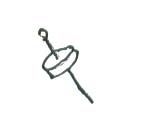

This is the same technique used to ply yarn so it stands to reason that cords would have been made the same way during the Middle Ages. These would make excellent cords for hanging things or for use as draw strings.
Items needed:
Drop Spindle
thread or yarn. 6 strand embroidery thread works well.
A drop spindle can be made from a dowel rod with a wooden wagon wheel or wooden disk from the craft store on the end and a small hook (for hanging mugs and other small items). The hook is placed in the end of the dowel where the wooden disk is. The wooden disk is glued in position a couple of inches up on the dowel rod. The dowel rod shaft needs to be about a foot long.

1 foot of finished cord requires approximately 2.5 foot of yarn or thread.
2 Strand Cord
1. Cut 2 strings the same length.
2. Tie all 4 ends together.
3. Separate the two loops.



3 Strand Cord
1. Cut 3 strands the same length.
2. Take 1 strand, fold in half and tie the two ends together. Wind away from yourself.
3. Take wound string off spindle and place where it won't unravel (between 2 hooks on a board or find a friend or a couple of friends to hold them for you.)
4. Do the same with the other 2 individual strings.
5. Tie the knotted ends of all three strings together and spin toward you.
6. Tie the loop end to keep it from raveling. Cord will loosen naturally a little. l
4 Strand Cord
1. Cut 4 strands the same length and tie the 8 ends together.
2. Separate out two loops on each side of the knot and hook the 2 loops fromone side on the spindle hook and spin away from you as before when working 2 strands.
3. Put all 4 loops on the hook whiel holding the knot end tightly and spin toward yourself.
4. Tie off the looped ends.
Return to the Medieval Arts Page.
Unless otherwise noted, all text and drawings are copyright 2002 P. Girard
Email the page owner Lady Almaith